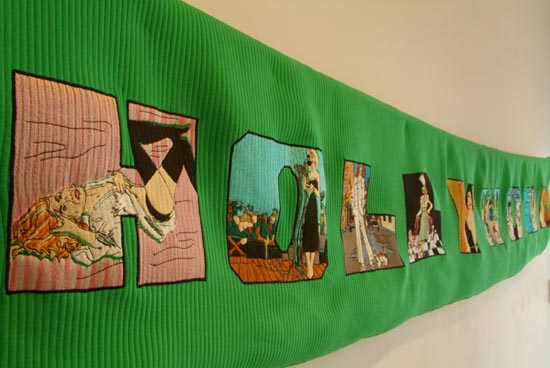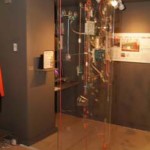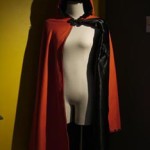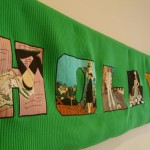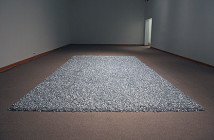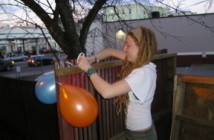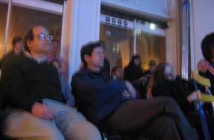Somewhere between the blueberry pie and the vampire costume, I paused to reflect on the thoughtfully tangled way that the forty plus artists of the Thread Counts Project succeeded in interpreting the show’s thematic structure. Inspired by how our conception of threads has undergone multifarious discursive permutation by new language and especially new technologies, curators Leila Lee Mitchell and Luanne Stovall organized an incredibly diverse show which focused on thread as a living metaphor weaving in and out of a multiplicity of meanings, situations and artistic practices.
Gina Dawson must like to sew almost as much as she likes watching movies, but I can’t say for sure. All I know is she has a terrifically intelligent eye for both. Dawson’s playful and provocative work immortalizes Hollywood in ways both ironic and sincere. It thrives on the cult of personality and voyeurism upon which “Tinsel Town” stands and yet also ingeniously transforms this silicone world into a site for reflection on media hype, the religion of television and screen celebrity, and the desire for fame. Hollywood is a fabric piece, like a painting in thread, which represents a group of female superstars whose faces have been replaced with Dawson’s. This act of substitution along with the labor of her craft is what painfully and importantly betrays her work’s seemingly straightforward pop facade. Dawson patiently inscribes her identity into that wholly famous otherness that is celebrity, an untouchable nirvana where everything, even the banal qualities of ones life, is raised to the status of gods, where simply living is breathtaking. It is this secret communal dream of American culture that Dawson’s art makes public.
In contrast, patching clothes is intimate. A patch leaves an indelible mark on the clothes and wearer announcing that someone took the time to fix it. But what if someone gratuitously and secretly sewed a patch into the inside of your clothes? You would know that someone had handled your clothes, so the intimacy implied even in that act transmogrifies into a kind of transgression. Enter Marissa Jahn, whose work inspired by vampire lore, riffs on the complicated connection between complicity and violation. Setting out with a list of “targets” and disguised in a hand made cape, she conned her way into people’s closets. Once there she surreptitiously cut a piece of her cape and sewed it into a clothing item on an area that she knew would touch their body. In this way she “violated” her victims as vampires do, relying in part on their victim’s own volition.
Her secretly shot video documents her encounters as well as rating the value of each target, based on how well Jahn knew the person (naturally family members ranked high on the list). It was all marvelously good and I thought (I’m going to say it) important. Violation, disguise, intrigue, and deception in our increasingly interconnected world are important issues and Jahn elaborates on them with a cold, impersonal, quasi-scientific conceptual zeal with just enough humor added in for balance. Her pink cape, draped over a female form, displayed like an empty husk - a retired mantle - still retains a certain ominous charge, un-divorced from the playfulness of a Halloween costume. Fabric, clothing, really all material changes once we know who wore it and what they did in it. Jahn’s Dismantled literally stitches the lives of her targets together. They’re bound together by their victimization, yet many remain unaware of their shared violation. Dismantled draws its lifeblood (if you will) by exposing the tenuous and convoluted relationships between secrecy, desire and betrayal.
At some point as I was lost in thought, the smell of blueberry pie caught my nose by surprise. Its something you don’t expect to smell in an art gallery. Leah Gauthier was serving it to any who wanted some; it was another dish in an ongoing menu of her performances that took food as their theme. In addition to this a sound track composed by Halsey Burgund wove recorded dialogues of people talking about food with sound creating a powerful music that resonated the layered associative meanings that food possesses. Food is an emotional substance, it causes fights, it can be political, it can be romantic, and it can be art. The dinner table is not an object only when food is placed on it and people gather around it to eat; then and there it becomes an active site for personal and communal exchange.
Finally and not lastly, I must mention Michael Sheridan’s Culture Catcher, a giant console of electronic gadgetry that picked up signals from all over the world. The piece was sensitive to its own environment in that it picked up on the motion of people in the gallery which (among other things) would trigger it to suddenly go off spilling its babble. Culture Catcher is tuned in to more than just radio signals: it’s attuned to major issues around and through which we communicate and live. It speaks of displacement, multiculturalism, interconnectivity as well as fragmentation. For me it was the keynote work of the show, in that it quite literally weaves together information, culture, and technology, but that the tapestry it creates is mutable, changing, unstable, open and receptive.
Links:
Thread Counts Project
Gallery Artists Studio Projects (GASP)
"Thread Counts Project" was on view until March 11th at GASP.
All images are by Thomas Gustanis and appear courtesy of the artists and GASP.

